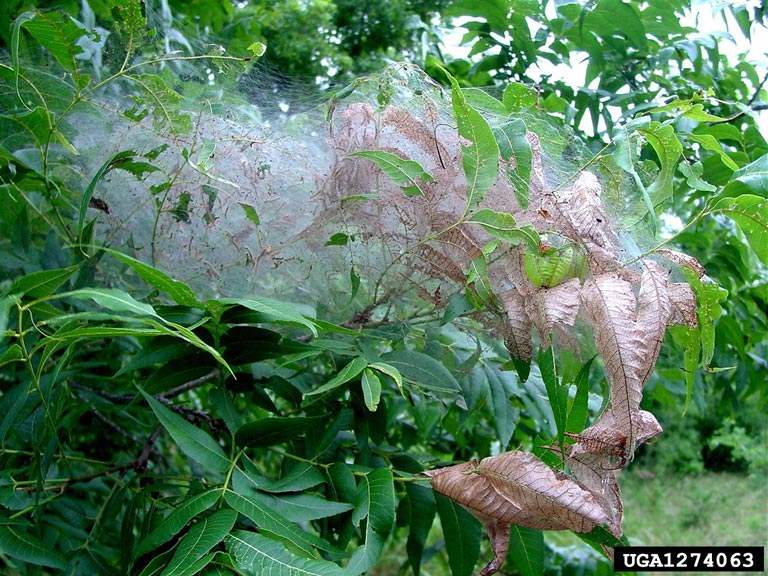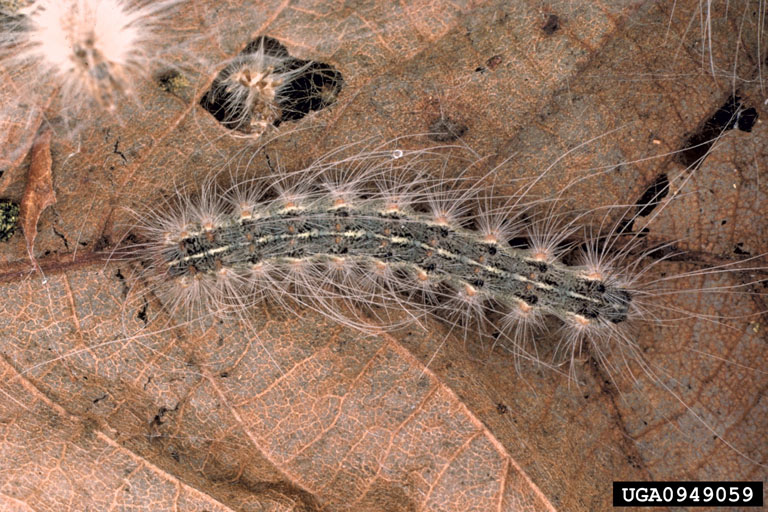
"What is this webby mass in my River Birch and is it going to kill the branches? My neighbor told me I should prune it all out of my tree and burn the branches." This is a common question received by Nebraska Extension in late summer and fall.
The fall webworm is most often discovered when the unsightly, light gray, silken webs are observed on the trees in late summer and early fall. Webworms enclose leaves and small branches in their nests, unlike the tent caterpillars which make a smaller nest in the crotch of branches. The large silk webs enclosing tips of branches are sure signs of fall webworms. The caterpillars remain inside the webbing, and if food runs out new foliage is encased.
Fall webworm attacks many hosts, over 85 known species of deciduous trees, including elm, hickory, pecan, plum, chokecherry, poplar, walnut and willow. In fact, almost all fruit, shade and ornamental trees, except conifers, can be affected by fall webworm. A similar insect, called Mimosa webworm, is very common on honeylocust.
 Insect Identification & Lifecycle
Insect Identification & Lifecycle
Homeowners often spot fall webworm as they enlarge their silken webs in late summer. Adults of this native insect are white moths, with reddish-orange front legs and a 1.25 inch wingspan. Immature insects are pale yellowish caterpillars with red heads and reddish-brown spots. An alternate color variation among the larva is yellow-green caterpillars with black heads a broad dark stripe on the back and black spots. The caterpillars have many long, fine hairs on their backs. There are one to two generations per year in Nebraska.
Adult moths emerge in late spring or early summer and lay eggs in masses on the undersides of leaves. The larvae emerge 10-14 days later and begin feeding in groups within a small webbed mass of leaves at the ends of branches. The webbing provides protection from some predators and the caterpillars feed inside the web until all leaves are devoured, then additional leaves are encased in the web. Webbed areas of leaves grow larger as the caterpillars mature, becoming a messy, ugly eyesore as it is filled with shed skins, excrement and leaf fragments.
The first generation of caterpillars matures in about six weeks. Then they drop to the ground and enter the soil, where they pupate into adults and re-emerge to lay eggs for the second generation. Some larvae may pupae under loose bark, in leaf litter beneath the tree, or within the webbing. Caterpillars of the second generation hatch and feed from approximately early August through late September. Then once again, the mature caterpillars drop to the ground to overwinter in the pupal stage. Pupae are usually in the ground but can be located in old nest remains, under loose bark and in leaf litter.
Because the insects overwinter beneath host plants, trees that have been attacked in the past will very likely have insects the following year, too.
Management
Though the webs are very unsightly, feeding by fall webworms is rarely seriously damaging to large trees. It's considered an insignificant threat to overall tree health. This pest tends to go through periodic population explosions. Outbreaks every four to seven years may last for two to three years and then natural control agents greatly reduce the activity.
Small nests can be pulled out of small to medium trees. Monitor trees early to detect the nests when only several leaves are involved. These small nests can be easily crushed. Do not burn or torch the nests in trees as this may do additional damage to the tree.
Over 80 species of parasites and predators have been identified in North America. Social wasps (yellow jackets and paper nest wasps), birds, predatory stink bugs and parasitic flies and wasps are the most important.
The web impedes most insecticides from reaching the insects, unless you can catch it early. One of the best ways to get rid of them is by taking a rake and breaking up the web. Or you can try a heavy stream of water to break up the webbing.
The bacterial insecticide, Bacillus thurengiensis (Bt), is quite effective against fall webworms if it is applied when the larvae are small. This product is sold as Dipel or Thuricide. Other insecticides, such as permethrin and bifenthrin, will also provide good control. Use formulations with UV protectants and thoroughly cover leaves next to nests. As these leaves are incorporated into the nest and eaten, the Bt will be ingested.
Extensive nests may occur in tall trees which are difficult to spray with ground equipment. These trees can often be treated with translocated systemics applied to the soil for root uptake or injected.
Image
- Fall webworm caterpillar. Image by James B. Hanson, USDA Forest Service, Bugwood.org